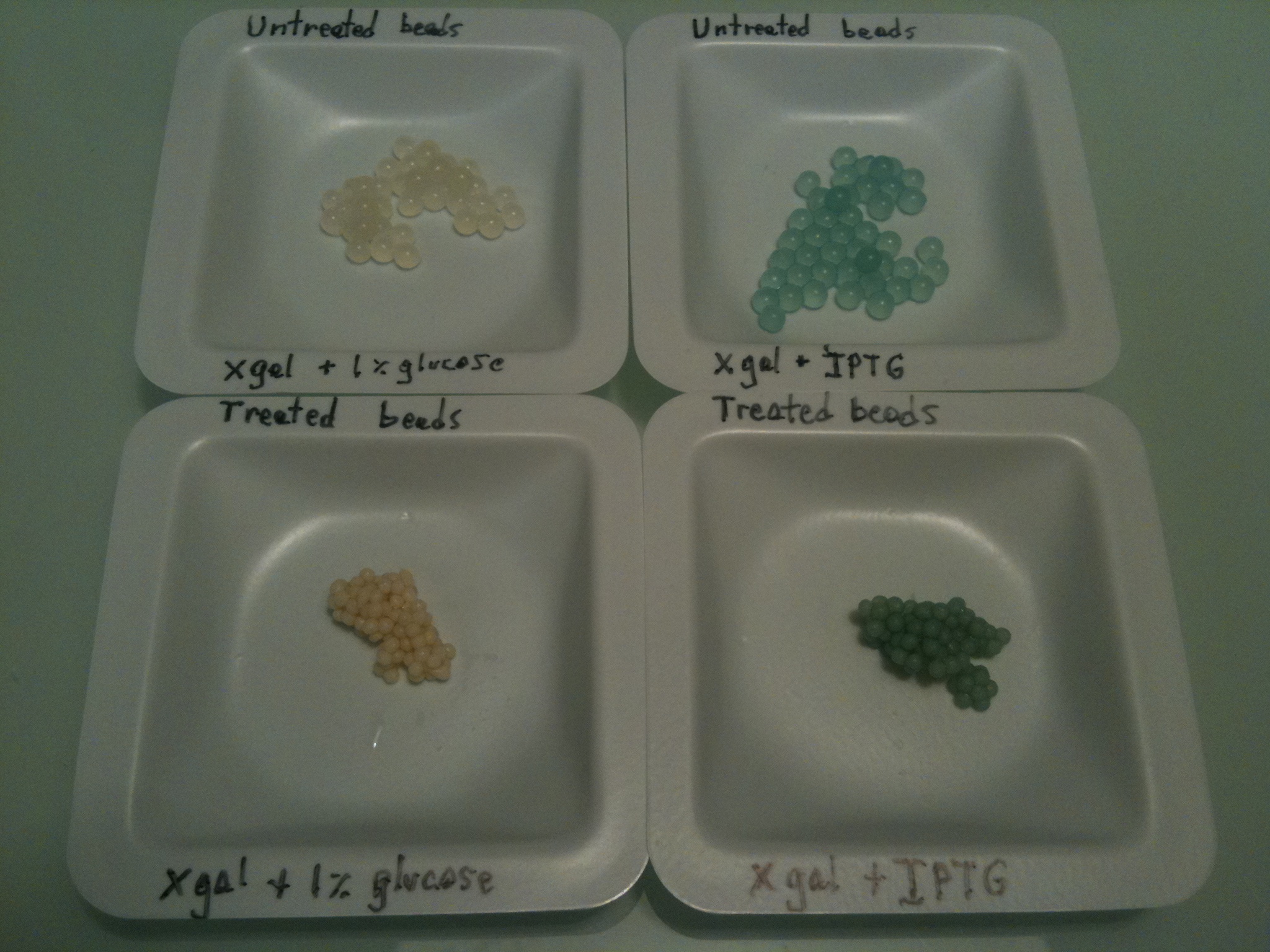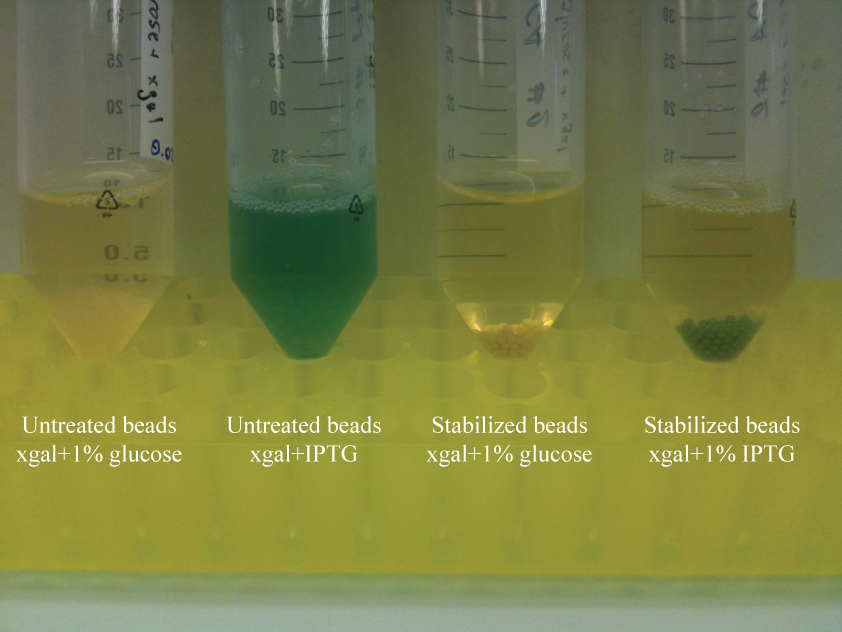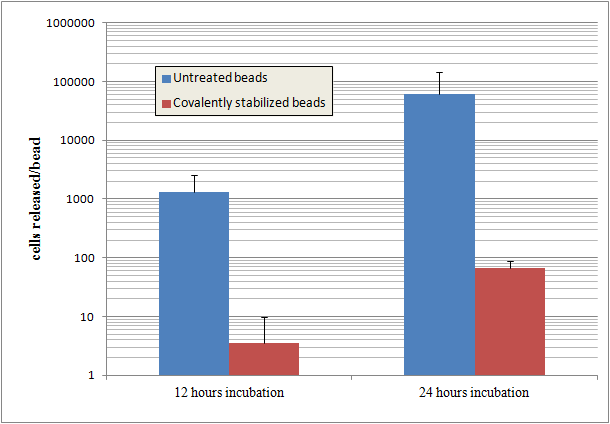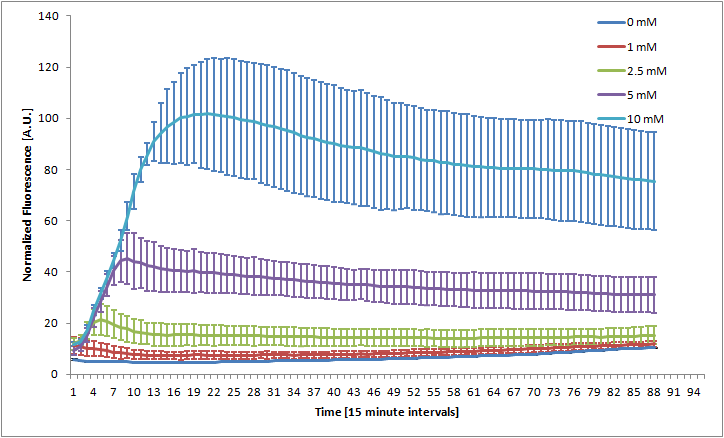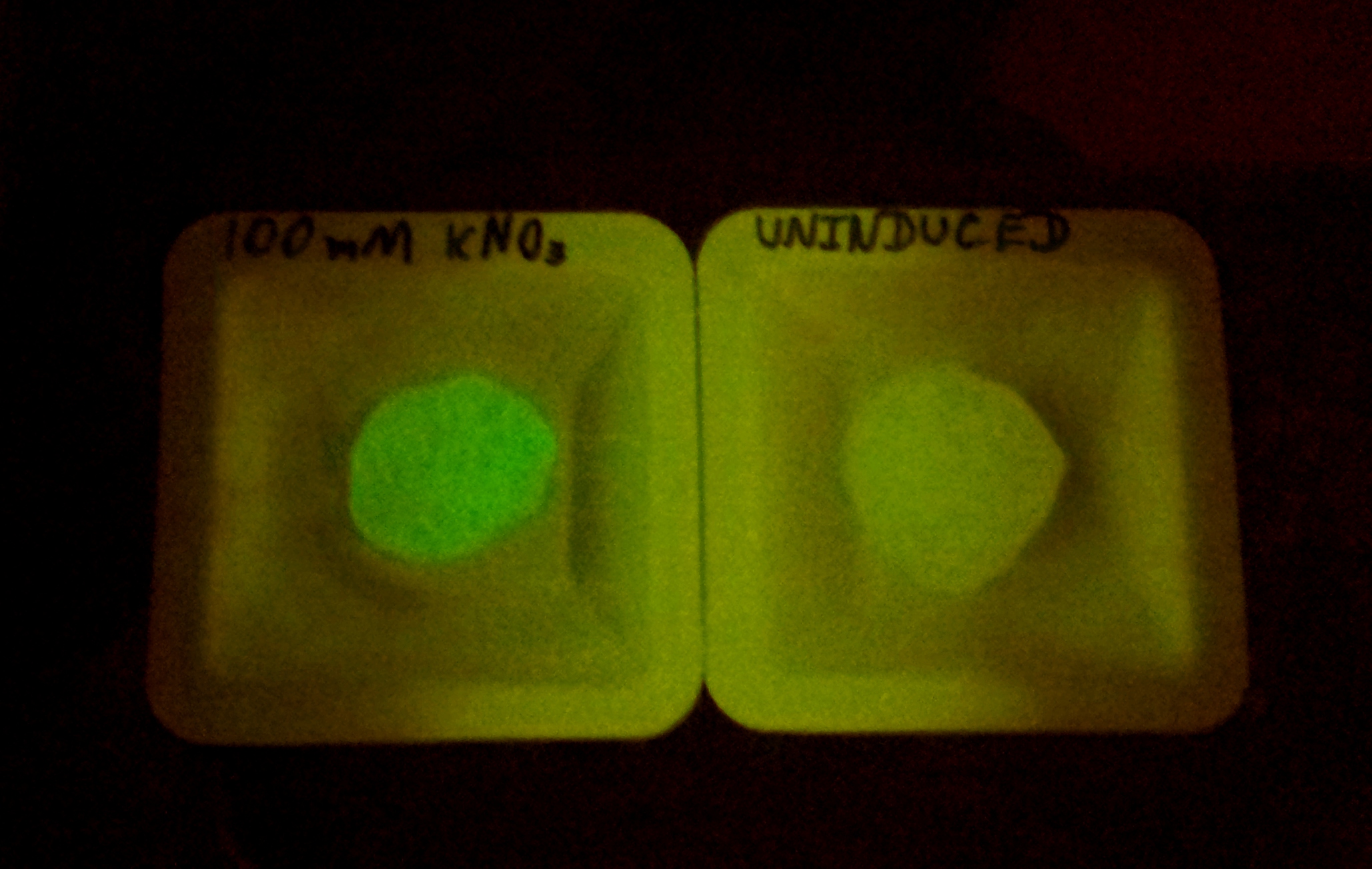Team:Paris Bettencourt/Encapsulation
From 2012.igem.org
Iversondylan (Talk | contribs) (→Design) |
(→Cell Containment Assay) |
||
| (48 intermediate revisions not shown) | |||
| Line 7: | Line 7: | ||
<tr> | <tr> | ||
<td> | <td> | ||
| - | ''' | + | '''Aims : ''' |
| - | + | Harness bacteria-containing gel beads to assure cell entrapment and complement activity of genetic safety systems. | |
| - | ''' | + | '''System : ''' |
| - | + | 2% alginate beads provide a controlled environment for cell growth. | |
| - | We performed [https://2012.igem.org/Team:Paris_Bettencourt/Encapsulation#Bristol_2010_Nitrate_Reporter additional characterization] of the Bristol 2010 nitrate reporter [http://partsregistry.org/Part:BBa_K381001 K381001] | + | '''Achievements :''' |
| + | *Encapsulated cells achieved and their ability to propagate and express proteins within alginate beads demonstrated. | ||
| + | *We performed [https://2012.igem.org/Team:Paris_Bettencourt/Encapsulation#Bristol_2010_Nitrate_Reporter additional characterization] of the Bristol 2010[1] nitrate reporter [http://partsregistry.org/Part:BBa_K381001 K381001] | ||
| + | *Efficient killing by colicin producing cells was achieved within the beads. | ||
| + | <div id="boston"> | ||
| + | '''Achievements : ''' | ||
| + | *Covalently stabilized alginate beads by polyethyleneimine and glutaraldehyde [https://2012.igem.org/Team:Paris_Bettencourt/Encapsulation#Covalent_Stabilization_of_Alginate_Beads treatment]. | ||
| + | *Demonstrated cells' ability to [https://2012.igem.org/Team:Paris_Bettencourt/Encapsulation#Blue-White_Screening_Assay propagate and express proteins] within stabilized alginate beads. | ||
| + | *Performed [https://2012.igem.org/Team:Paris_Bettencourt/Encapsulation#Cell_Containment_Assay cell containment assay] that demonstrated stabilized beads' enhanced cell entrapment capacity in phosphate buffer. | ||
| - | + | </div> | |
| - | + | ||
</td> | </td> | ||
</tr> | </tr> | ||
| Line 25: | Line 32: | ||
Polymer gels have found a place in microbial biotechnology by providing a means of spatial organization. The micro-environments within gel beads can grant the microbes within protection, nutrients, and selective agents/chemicals. Given this, gel beads are already attractive for environmental applications of genetically modified bacteria. Synthetic bacterial systems may benefit from (or require) nutrients and agents added to gel beads. Many other practical reasons for use of beads exist, such as transportation and analysis. | Polymer gels have found a place in microbial biotechnology by providing a means of spatial organization. The micro-environments within gel beads can grant the microbes within protection, nutrients, and selective agents/chemicals. Given this, gel beads are already attractive for environmental applications of genetically modified bacteria. Synthetic bacterial systems may benefit from (or require) nutrients and agents added to gel beads. Many other practical reasons for use of beads exist, such as transportation and analysis. | ||
| - | Our interest is to take the concept of cell encapsulation further by implementing total cell entrapment. While normal gel beads protect the bacteria within from the surroundings, we are here to ensure the surroundings are protected from the bacteria within the beads. A method was found for encapsulation and entrapment of yeast [ | + | Our interest is to take the concept of cell encapsulation further by implementing total cell entrapment. While normal gel beads protect the bacteria within from the surroundings, we are here to ensure the surroundings are protected from the bacteria within the beads. A method was found for encapsulation and entrapment of yeast [2] and was adapted to synthetic bacterial systems. |
| - | [[File: | + | [[File:Paris_Bettencourt_2012_beads_on_plates.JPG|frameless|center|600px]] |
| + | |||
| + | The above beads show the visual contrast between treated and untreated alginate beads. The smaller, denser ones are treated, and the softer, translucent ones are not. | ||
==Objectives== | ==Objectives== | ||
Our goal is to design a live-bacteria entrapment system. More than just encapsulating bacteria, we want to fully prevent their escape from the bead body into the surroundings. | Our goal is to design a live-bacteria entrapment system. More than just encapsulating bacteria, we want to fully prevent their escape from the bead body into the surroundings. | ||
| - | Alginate and other gel-based beads have been used successfully to prolong enzymatic activity in bioreactors[ | + | Alginate and other gel-based beads have been used successfully to prolong enzymatic activity in bioreactors[3], but systems such as these are usually designed to allow steady release of microbes. This is not acceptable when microbes containing potentially dangerous synthetic genes are being used in the environment, so we aim to prevent release of bacteria entirely. |
| + | |||
| + | <div id="boston"> | ||
| + | ==Covalent Stabilization of Alginate Beads== | ||
| + | |||
| + | A detailed protocol for creation of stabilized alginate beads can be found [http://openwetware.org/wiki/IGEM:Paris_Bettencourt_2012/Protocols/stabilized_beads here]. | ||
| - | |||
Cell-containing 2% alginate can be created by mixing 4% alginate in equal parts with cell suspension. Alginate beads are created by extruding 2% alginate beads through a needle into 1.5% CaCl2 solution and curing for 1 hour. The beads are then equilibrated at 50mM CaCl2 overnight. | Cell-containing 2% alginate can be created by mixing 4% alginate in equal parts with cell suspension. Alginate beads are created by extruding 2% alginate beads through a needle into 1.5% CaCl2 solution and curing for 1 hour. The beads are then equilibrated at 50mM CaCl2 overnight. | ||
| Line 41: | Line 54: | ||
[[File:ParisBettencourtPolyethyleneimineAlginate.png|center|950px|Protocol for covalent stabilization of live-bacteria containing alginate beads]] | [[File:ParisBettencourtPolyethyleneimineAlginate.png|center|950px|Protocol for covalent stabilization of live-bacteria containing alginate beads]] | ||
| + | </div> | ||
==Experiments and results== | ==Experiments and results== | ||
| - | === | + | <div id="boston"> |
| - | + | ===Blue-White Screening Assay=== | |
| + | We had some concerns regarding the toxicity of chemicals used for the covalent stabilization of alginate. Glutaraldehyde, specifically, is used to fix and kill cells. We found, however, that cells are protected within the beads from death by glutaraldehyde. We demonstrated this by a white-blue screening assay. BL21 strain (LacZα fragment inducible by IPTG) was used. | ||
| - | + | * 2% Alginate beads containing cells were prepared (10mL saturated culture mixed with 10 mL 4% Alginate). | |
| - | * 2% Alginate beads containing cells were prepared ( | + | * 4g beads were washed with MgSO4 once and set aside at 4°C (untreated alginate beads). |
| + | * 4g beads were treated as described above with polyethyleneimine and glutaraldehyde. | ||
| + | * Treated and untreated beads were separated into tubes of LB containing either xgal and 1% glucose (for efficient repression of LacZα) or xgal and IPTG. | ||
| - | + | ====Results==== | |
| - | + | [[File:Paris_bettencourt_2012_Beads-in-lb.png|frameless|center|600px]] | |
| - | + | Both treated and untreated beads turn blue in the assay. Because the cells within beads were not induced prior to encapsulation, this indicated that cells are able to grow and express proteins within the beads. Interestingly, the supernatant of the induced untreated beads is blue, indicating release of cells. The supernatant of the induced stabilized beads is not blue. This suggests efficient entrapment of cells in the stabilized beads, but another assay is required to validate this result. | |
| + | </div> | ||
| - | + | <div id="boston"> | |
| - | + | ===Cell Containment Assay=== | |
| - | + | Our objective is to entrap cells that are still viable and able to perform metabolism. To asses this, beads were suspended in buffer and allowed to incubate at room temperature over several days. Phosphate is particularly destructive to alginate beads, but our covalently stabilized beads retain integrity even in phosphate. | |
| + | ====Experimental setup==== | ||
| + | * 2% Alginate beads containing cells were prepared (10mL saturated culture mixed with 10 mL 4% Alginate). | ||
| + | * 2g beads were washed with MgSO4 once and set aside at 4°C (untreated alginate beads). | ||
| + | * 2g beads were treated as described above with polyethyleneimine and glutaraldehyde. | ||
| + | * Untreated and Stabilized beads were added to 10 mL PBS buffer and left at room temperature. | ||
| + | * Supernatant was plated at 12 hours and 24 hours incubation at different dilutions to quantify release of cells. | ||
====Results==== | ====Results==== | ||
| - | |||
| - | |||
| - | |||
| - | |||
| - | |||
| - | |||
| - | |||
| - | |||
| - | |||
| - | |||
| - | |||
| - | |||
| - | |||
| - | |||
| - | |||
| - | |||
| - | |||
| - | |||
| - | |||
| - | |||
| - | |||
| - | |||
| - | |||
| - | |||
| - | == | + | [[File:Paris_Bettencourt_2012_Cell_release_assay.png|frameless|center|600px]] |
| - | + | Beads that are covalently stabilized entrap cells much more effectively than untreated alginate beads. The untreated beads release cells at a rate up to 1000 times more than the stabilized beads. | |
| + | |||
| + | Alginate beads are disrupted by the phosphate in PBS buffer. Despite this, stabilized beads still show a high degree of cell entrapment after 24 hours. | ||
| + | </div> | ||
| + | |||
| + | ===Preliminary Colicin system test=== | ||
| + | A mixture of 50% RPF expressing and 50% colicin producing cells was encapsulated in alginate beads. As a control, RFP producing cells were encapsulated with wild type cells. After incubating the beads in LB for about 12 hours, the two different mixtures were compared. The number of cells that had grown in the supernatant of the colicin-bearing mixture was 2.5 times less than in the supernatant of the mixture. This indicates that the combination of colicin-toxin system is effective with the use of alginate beads. | ||
==Bristol 2010 Nitrate Reporter== | ==Bristol 2010 Nitrate Reporter== | ||
[[File:ParisBettencourt12NitrateReporter.png|frameless|center|600px]] | [[File:ParisBettencourt12NitrateReporter.png|frameless|center|600px]] | ||
| + | The Bristol 2010 team probably did not have access to an automated kinetic fluorescence and OD measurement device. We monitored GFP expression level at different KNO3 induction levels in order to better characterize the part. | ||
| + | |||
[[File:ParisBettencourt12Beads1.jpg|frameless|center|600px]] | [[File:ParisBettencourt12Beads1.jpg|frameless|center|600px]] | ||
| + | Alginate beads were created (uninduced) and then incubated in plain LB and LB with 100mM KNO3. The difference in green fluorescence was visible by eye under the Illumatool. | ||
| + | |||
| + | ==References== | ||
| + | 1. agrEcoli, Bristol 2010 igem team [https://2010.igem.org/Team:BCCS-Bristol wiki] | ||
| + | |||
| + | 2. Birnbaum, S., Pendleton, R., Larsson, P.-O. & Mosbach, K. Covalent stabilization of alginate gel for the entrapment of living whole cells. Biotechnology Letters 3, 393-400 (1981). [http://dx.doi.org/10.1007/BF01134097 Paper] | ||
| + | 3. Boon, N. et al. Bioaugmenting bioreactors for the continuous removal of 3-chloroaniline by a slow release approach. Environmental science & technology 36, 4698-4704 (2002). [http://view.ncbi.nlm.nih.gov/pubmed/12433184 Paper] | ||
<!-- ########## Don't edit below ########## --> | <!-- ########## Don't edit below ########## --> | ||
{{:Team:Paris_Bettencourt/footer}} | {{:Team:Paris_Bettencourt/footer}} | ||
Latest revision as of 23:51, 26 October 2012
|
Aims : Harness bacteria-containing gel beads to assure cell entrapment and complement activity of genetic safety systems. System : 2% alginate beads provide a controlled environment for cell growth. Achievements :
Achievements :
|
Contents |
Overview
Polymer gels have found a place in microbial biotechnology by providing a means of spatial organization. The micro-environments within gel beads can grant the microbes within protection, nutrients, and selective agents/chemicals. Given this, gel beads are already attractive for environmental applications of genetically modified bacteria. Synthetic bacterial systems may benefit from (or require) nutrients and agents added to gel beads. Many other practical reasons for use of beads exist, such as transportation and analysis.
Our interest is to take the concept of cell encapsulation further by implementing total cell entrapment. While normal gel beads protect the bacteria within from the surroundings, we are here to ensure the surroundings are protected from the bacteria within the beads. A method was found for encapsulation and entrapment of yeast [2] and was adapted to synthetic bacterial systems.
The above beads show the visual contrast between treated and untreated alginate beads. The smaller, denser ones are treated, and the softer, translucent ones are not.
Objectives
Our goal is to design a live-bacteria entrapment system. More than just encapsulating bacteria, we want to fully prevent their escape from the bead body into the surroundings.
Alginate and other gel-based beads have been used successfully to prolong enzymatic activity in bioreactors[3], but systems such as these are usually designed to allow steady release of microbes. This is not acceptable when microbes containing potentially dangerous synthetic genes are being used in the environment, so we aim to prevent release of bacteria entirely.
Covalent Stabilization of Alginate Beads
A detailed protocol for creation of stabilized alginate beads can be found [http://openwetware.org/wiki/IGEM:Paris_Bettencourt_2012/Protocols/stabilized_beads here].
Cell-containing 2% alginate can be created by mixing 4% alginate in equal parts with cell suspension. Alginate beads are created by extruding 2% alginate beads through a needle into 1.5% CaCl2 solution and curing for 1 hour. The beads are then equilibrated at 50mM CaCl2 overnight.
Covalent Stabilization procedure: Polyethyleneimine (0.5% w/v with 50mM CaCl2) diffuses slowly into alginate beads over 2-24 hours to vary thickness. The beads are washed with water. The covalent cross-linkages are formed between polyethyleneimine molecules by incubating in glutaraldehyde (1% with 10mM sodium phosphate pH=7) for 1 minute followed by washing.
Experiments and results
Blue-White Screening Assay
We had some concerns regarding the toxicity of chemicals used for the covalent stabilization of alginate. Glutaraldehyde, specifically, is used to fix and kill cells. We found, however, that cells are protected within the beads from death by glutaraldehyde. We demonstrated this by a white-blue screening assay. BL21 strain (LacZα fragment inducible by IPTG) was used.
- 2% Alginate beads containing cells were prepared (10mL saturated culture mixed with 10 mL 4% Alginate).
- 4g beads were washed with MgSO4 once and set aside at 4°C (untreated alginate beads).
- 4g beads were treated as described above with polyethyleneimine and glutaraldehyde.
- Treated and untreated beads were separated into tubes of LB containing either xgal and 1% glucose (for efficient repression of LacZα) or xgal and IPTG.
Results
Both treated and untreated beads turn blue in the assay. Because the cells within beads were not induced prior to encapsulation, this indicated that cells are able to grow and express proteins within the beads. Interestingly, the supernatant of the induced untreated beads is blue, indicating release of cells. The supernatant of the induced stabilized beads is not blue. This suggests efficient entrapment of cells in the stabilized beads, but another assay is required to validate this result.
Cell Containment Assay
Our objective is to entrap cells that are still viable and able to perform metabolism. To asses this, beads were suspended in buffer and allowed to incubate at room temperature over several days. Phosphate is particularly destructive to alginate beads, but our covalently stabilized beads retain integrity even in phosphate.
Experimental setup
- 2% Alginate beads containing cells were prepared (10mL saturated culture mixed with 10 mL 4% Alginate).
- 2g beads were washed with MgSO4 once and set aside at 4°C (untreated alginate beads).
- 2g beads were treated as described above with polyethyleneimine and glutaraldehyde.
- Untreated and Stabilized beads were added to 10 mL PBS buffer and left at room temperature.
- Supernatant was plated at 12 hours and 24 hours incubation at different dilutions to quantify release of cells.
Results
Beads that are covalently stabilized entrap cells much more effectively than untreated alginate beads. The untreated beads release cells at a rate up to 1000 times more than the stabilized beads.
Alginate beads are disrupted by the phosphate in PBS buffer. Despite this, stabilized beads still show a high degree of cell entrapment after 24 hours.
Preliminary Colicin system test
A mixture of 50% RPF expressing and 50% colicin producing cells was encapsulated in alginate beads. As a control, RFP producing cells were encapsulated with wild type cells. After incubating the beads in LB for about 12 hours, the two different mixtures were compared. The number of cells that had grown in the supernatant of the colicin-bearing mixture was 2.5 times less than in the supernatant of the mixture. This indicates that the combination of colicin-toxin system is effective with the use of alginate beads.
Bristol 2010 Nitrate Reporter
The Bristol 2010 team probably did not have access to an automated kinetic fluorescence and OD measurement device. We monitored GFP expression level at different KNO3 induction levels in order to better characterize the part.
Alginate beads were created (uninduced) and then incubated in plain LB and LB with 100mM KNO3. The difference in green fluorescence was visible by eye under the Illumatool.
References
1. agrEcoli, Bristol 2010 igem team wiki
2. Birnbaum, S., Pendleton, R., Larsson, P.-O. & Mosbach, K. Covalent stabilization of alginate gel for the entrapment of living whole cells. Biotechnology Letters 3, 393-400 (1981). [http://dx.doi.org/10.1007/BF01134097 Paper]
3. Boon, N. et al. Bioaugmenting bioreactors for the continuous removal of 3-chloroaniline by a slow release approach. Environmental science & technology 36, 4698-4704 (2002). [http://view.ncbi.nlm.nih.gov/pubmed/12433184 Paper]
 "
"


 Overview
Overview Delay system
Delay system Semantic containment
Semantic containment Restriction enzyme system
Restriction enzyme system MAGE
MAGE Encapsulation
Encapsulation Synthetic import domain
Synthetic import domain Safety Questions
Safety Questions Safety Assessment
Safety Assessment